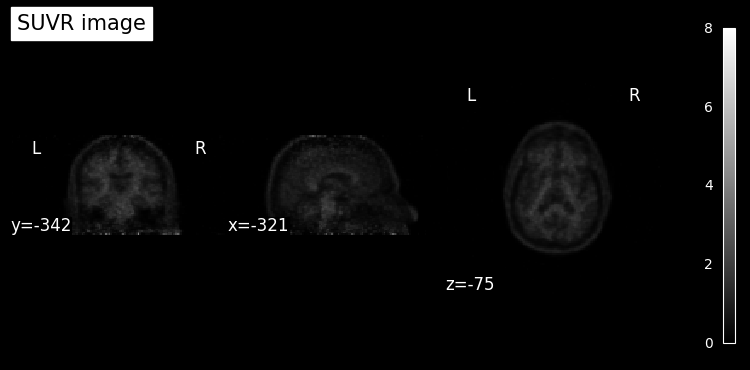Standardized Uptake Value Ratio¶
To illustrate standardized uptake value ratio (SUVR) calculation, we will download an 18F-AV45 amyloid PET scan from The Dallas Lifespan Brain Study via OpenNeuro. This PET scan is reconstructed as a single time frame, so it is a 3-D image. (We can still use Dynamic PET to read it, but most of the functions implemented in Dynamic PET will not be relevant.)
from pathlib import Path
import requests
outdir = Path.cwd() / "nb_data"
outdir.mkdir(exist_ok=True)
petjson_fname = outdir / "pet_av45.json"
pet_fname = outdir / "pet_av45.nii.gz"
baseurl = "https://s3.amazonaws.com/openneuro.org/ds004856/sub-1003/ses-wave1/pet/"
peturl = (
baseurl
+ "sub-1003_ses-wave1_trc-18FAV45_run-1_pet.nii.gz"
+ "?versionId=qL.9p.hInakWrNSF1LeefT4VOIuBy6Xm"
)
if not petjson_fname.exists():
r = requests.get(
baseurl
+ "sub-1003_ses-wave1_trc-18FAV45_run-1_pet.json"
+ "?versionId=HvaYMcTWZjYwq6GVwjfeePZ9dKAtJlFM",
timeout=10,
)
r.raise_for_status()
with open(petjson_fname, "wb") as f:
f.write(r.content)
if not pet_fname.exists():
with requests.get(peturl, timeout=10, stream=True) as r:
r.raise_for_status()
with open(pet_fname, "wb") as f:
for chunk in r.iter_content(chunk_size=8192):
f.write(chunk)
At the time of writing of this notebook, this dataset is not PET-BIDS valid.
Trying to read it with the load function from
dynamicpet.petbids.petbidsimage will fail.
Because of this, we need to fix the json first.
We can first read the json using the read_json from the same module.
read_json does not perform any validity checks (and does not look at the
corresponding imaging data at all).
from dynamicpet.petbids.petbidsjson import read_json
json = read_json(petjson_fname)
The problem with this dataset is that the image contains only a single time frame, but the json indicates two time frames, with the second one having a duration of 0.
print(f"FrameDuration: {json["FrameDuration"]}")
print(f"FrameTimesStart: {json["FrameTimesStart"]}")
FrameDuration: [600000, 0]
FrameTimesStart: [0, 600000]
We modify these tags by keeping their first element only.
json.update(
{
"FrameDuration": json["FrameDuration"][:1],
"FrameTimesStart": json["FrameTimesStart"][:1],
}
)
print(f"FrameDuration: {json["FrameDuration"]}")
print(f"FrameTimesStart: {json["FrameTimesStart"]}")
FrameDuration: [600000]
FrameTimesStart: [0]
Now that the frame timing information is fixed, we update the json file using
the write_json function:
from dynamicpet.petbids.petbidsjson import write_json
write_json(json, petjson_fname)
Now, reading in this dataset will work:
from dynamicpet.petbids.petbidsimage import load
pet = load(pet_fname)
To calculate SUVR, we need to specify a reference region. Usually, some type of cerebellar reference would be used for 18F-AV45. In this notebook, however, we use an (approximate) whole brain reference region for simplicity.
from nilearn.image import threshold_img
from nilearn.masking import compute_background_mask
from nilearn.plotting import plot_anat
from scipy.ndimage import binary_fill_holes
# get an approximate brain mask
refmask = compute_background_mask(
threshold_img(pet.img, threshold=1400, two_sided=False),
connected=True,
opening=3,
)
refmask_data = binary_fill_holes(refmask.get_fdata())
refmask = refmask.__class__(refmask_data.astype("float"), affine=refmask.affine)
display = plot_anat(
pet_fname,
colorbar=True,
draw_cross=False,
title="Reference region (brain) mask overlaid on PET",
)
display.add_overlay(refmask, alpha=0.5)
/var/folders/y6/nj790rtn62lfktb1sh__79hc0000gn/T/ipykernel_3434/2637949575.py:9: FutureWarning: From release 0.13.0 onwards, this function will, by default, copy the header of the input image to the output. Currently, the header is reset to the default Nifti1Header. To suppress this warning and use the new behavior, set `copy_header=True`.
threshold_img(pet.img, threshold=1400, two_sided=False),
/var/folders/y6/nj790rtn62lfktb1sh__79hc0000gn/T/ipykernel_3434/2637949575.py:22: UserWarning: kwargs['alpha']=0.5 detected in parameters.
Overriding with transparency=None.
To suppress this warning pass your 'alpha' value via the 'transparency' parameter.
display.add_overlay(refmask, alpha=0.5)

Next, we calculate the mean time activity “curve” (TAC) in this reference region mask.
reftac = pet.mean_timeseries_in_mask(mask=refmask.get_fdata())
reftac.dataobj
array([[2910.44148055]])
Since this PET image has a single time frame, the “TAC” will also have a single element.
reftac.dataobj
array([[2910.44148055]])
We can fit the SUVR model as follows:
from dynamicpet.kineticmodel.suvr import SUVR
res = SUVR(reftac, pet)
res.fit()
We can see the names of the parameters using the get_param_names function.
The only parameter available in the SUVR class is suvr:
res.get_param_names()
['SUVR']
The best way to access the calculated parameter is via the get_parameter
function, which will appropriately reshape the calculated parameter if needed
and make it into a SpatialImage.
We can then use nilearn functions to plot the image.
plot_anat(
res.get_parameter("SUVR"),
colorbar=True,
draw_cross=False,
title="SUVR image",
);

Command line interface¶
Instead of using the Python API, we can also perform SUVR calculation via the command line.
First, we need to have the reference region mask to disk.
refmask.to_filename("nb_data/refmask.nii.gz")
Then, we can run the command from terminal:
!kineticmodel nb_data/pet_av45.nii.gz --model SUVR --refmask nb_data/refmask.nii.gz --outputdir nb_data
The SUVR image will be saved to a file suffixed with _km-suvr_kp-suvr,
where km stands for kinetic model and kp stands for kinetic parameter.
This file naming convention is based on the PET-BIDS Derivatives Extension
(work in progress).